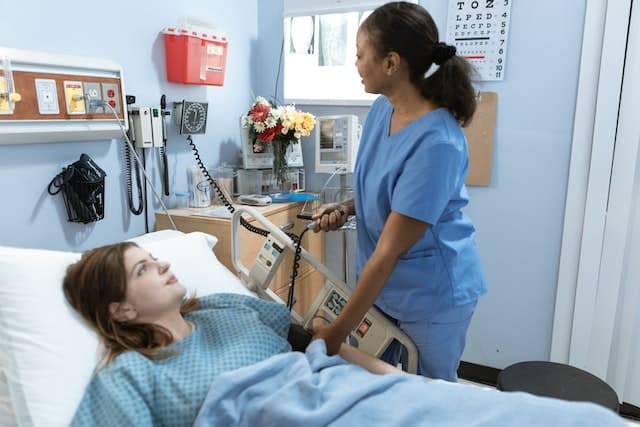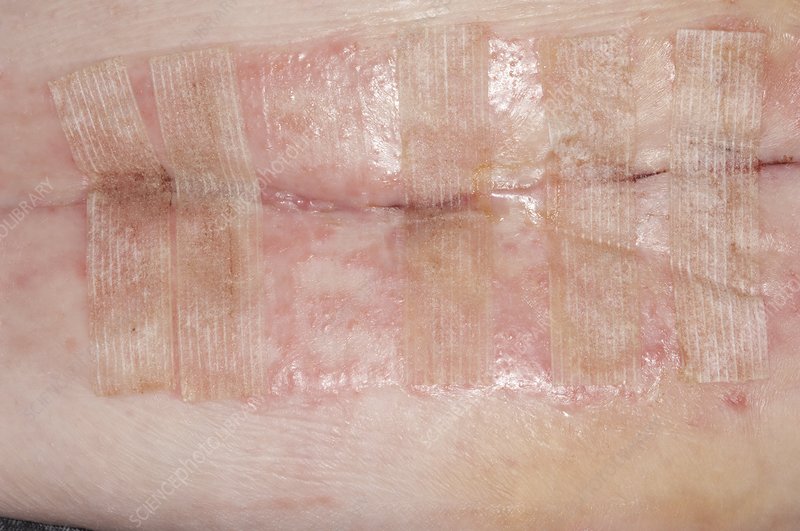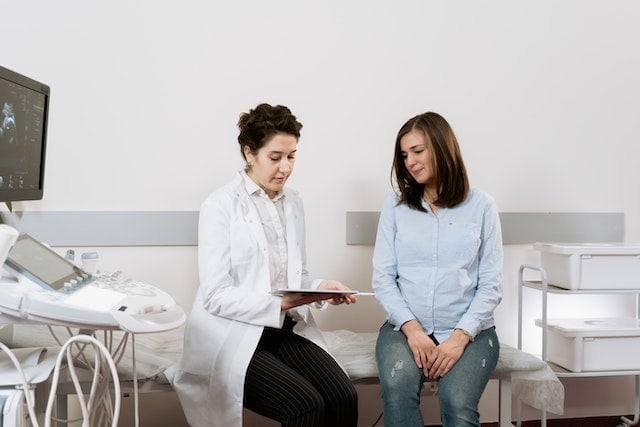Steri-strips are a common wound closure method used after a C-section. These thin adhesive strips are placed over the incision to hold the edges of the wound together as it heals.
They are often used in combination with internal sutures or staples to provide additional support and reduce tension on the incision site.
Understanding how long steri-strips stay on after a C-section is important for proper wound care and management. While the length of time can vary depending on individual factors, such as the size and location of the incision, most steri-strips are designed to stay in place for several days to a week.
It is important to follow your healthcare provider’s specific instructions for care and removal of the steri-strips to ensure proper healing and minimize the risk of complications.
Key Takeaways
- Steri-strips are a common wound closure method used after a C-section to hold the edges of the incision together as it heals.
- Most steri-strips are designed to stay in place for several days to a week, but the length of time can vary depending on individual factors.
- It is important to follow your healthcare provider’s specific instructions for care and removal of the steri-strips to ensure proper healing and minimize the risk of complications.
Understanding Steri-Strips After a C-Section
After a C-section, the doctor may use Steri-Strips to close the incision. Steri-Strips are thin adhesive strips that are placed over the incision to help keep the edges of the wound together. They are typically used in conjunction with dissolvable stitches or staples.
Steri-Strips are designed to stay on the incision until it has healed enough to support itself. The length of time that Steri-Strips stay on after a C-section can vary depending on the doctor’s preference and the patient’s healing process.
In general, Steri-Strips can stay on for anywhere from 5 to 10 days.
It is important for patients to follow their doctor’s instructions regarding the care of their incision and the Steri-Strips. Patients should avoid getting their incision wet until the Steri-Strips are removed.
They should also avoid any strenuous activity that could put stress on the incision.
If the Steri-Strips become loose or fall off before the recommended time, patients should contact their doctor. The doctor may want to replace the Steri-Strips or check the incision to ensure that it is healing properly.
In summary, Steri-Strips are a common method of closing the incision after a C-section. They are designed to stay on until the incision has healed enough to support itself, typically for 5 to 10 days.
Patients should follow their doctor’s instructions regarding the care of their incision and contact their doctor if the Steri-Strips become loose or fall off before the recommended time.
The Role of Steri-Strips in Wound Healing
After a C-section, the incision site is closed using either stitches or glue. In some cases, steri-strips are also used to help hold the incision closed and promote proper healing.
Steri-strips are thin adhesive strips that are placed over the incision site to provide support and prevent the edges of the incision from pulling apart.
The use of steri-strips in wound healing is not new, and they have been used for many years in various medical procedures. They are particularly useful in cases where stitches or glue alone may not be enough to hold the wound closed.
Steri-strips are made from a non-woven fabric that is coated with a medical-grade adhesive. They are designed to be strong enough to hold the wound closed, but flexible enough to allow for movement without causing discomfort or irritation.
When applied correctly, steri-strips can help reduce the risk of infection and scarring, as well as promote faster healing. They are typically left in place for several days, and may be removed by a healthcare provider or allowed to fall off naturally as the wound heals.
Overall, the role of steri-strips in wound healing is to provide additional support and promote proper healing of the incision site. While they may not be necessary in all cases, they can be a valuable tool in promoting optimal healing after a C-section.
How Long Steri-Strips Stay On
After a C-section, steri-strips are placed over the incision to help keep it closed and promote healing. These small adhesive strips are typically left on for a period of time before they can be removed.
The length of time that steri-strips stay on can vary depending on the individual and the surgeon’s preference. In general, they are left on for about 5-10 days, but some surgeons may recommend leaving them on for up to 14 days.
It is important to follow your surgeon’s instructions regarding when to remove the steri-strips. Removing them too early can increase the risk of the incision opening up or becoming infected, while leaving them on for too long can cause skin irritation or even delay healing.
During the recovery period, it is important to keep the incision site clean and dry to prevent infection. If you notice any signs of infection, such as redness, swelling, or drainage, contact your healthcare provider immediately.
Overall, steri-strips can be an effective way to promote healing and reduce the risk of complications after a C-section. By following your surgeon’s instructions and monitoring the incision site for signs of infection, you can help ensure a smooth and successful recovery.
Caring for Your Incision Post C-Section
After a C-section, it is important to take proper care of your incision to promote healing and reduce the risk of infection. Here are some tips to help you care for your incision:
Cleaning
It is important to keep your incision clean and dry to prevent infection. You can clean your incision with soap and water, or as directed by your healthcare provider. Be sure to pat the area dry with a clean towel after cleaning.
Showering
You can shower after your incision has been checked by your healthcare provider and the dressing has been removed. Avoid taking baths or swimming until your incision has completely healed.
Dressing
Your healthcare provider may apply a sterile dressing to your incision after surgery. It is important to keep the dressing clean and dry. If the dressing becomes wet or dirty, contact your healthcare provider.
Bandages
Your healthcare provider may use steri-strips to hold the edges of your incision together. These strips will typically fall off on their own within a week or two. Avoid pulling on the strips or removing them yourself.
In summary, proper care of your incision after a C-section is crucial for a speedy recovery. Be sure to follow your healthcare provider’s instructions and contact them if you have any concerns or questions.
Potential Complications and Risks
Although steri strips are generally safe and effective in promoting wound healing, there are potential complications and risks associated with their use after a C-section. These risks include infection, fever, bleeding, swelling, pain, and bacterial growth.
One of the most common complications associated with steri strips is infection. If the wound is not properly cleaned and disinfected before applying the strips, bacteria can grow under them and cause an infection. Signs of infection include redness, swelling, warmth, and pus or discharge from the wound.
In addition to infection, fever can also be a sign of complications after a C-section. If the patient develops a fever, it may be a sign of infection or other complications such as blood clots or inflammation.
Bleeding is another potential risk associated with the use of steri strips. If the wound is not properly closed or if the patient has a bleeding disorder, excessive bleeding may occur. Signs of excessive bleeding include bleeding through the dressing or bandage and a sudden increase in pain or swelling.
Swelling and pain are also common after a C-section. While these symptoms are generally mild and go away on their own, they can be exacerbated by the use of steri strips.
If the strips are too tight or if they are applied incorrectly, they can cause additional pain and swelling.
Finally, bacterial growth is a potential risk associated with the use of steri strips. If the strips are not changed regularly or if they become wet or dirty, bacteria can grow under them and cause an infection.
It is important to follow the instructions provided by the healthcare provider and to keep the wound clean and dry to minimize the risk of bacterial growth.
Overall, while steri strips are generally safe and effective in promoting wound healing after a C-section, there are potential complications and risks associated with their use.
Patients should be aware of these risks and should seek medical attention if they experience any signs of complications or if they have any concerns about their healing process.
Managing Pain and Discomfort
After a C-section, it is common for women to experience pain and discomfort. Managing this pain is important for a smooth recovery. There are several ways to manage pain and discomfort, including medication and self-care.
Pain medication such as ibuprofen and acetaminophen can be effective in managing post-C-section pain. These medications can be taken orally or through an IV.
It is important to follow the advice of a healthcare professional when taking medication, including dosage and frequency.
In addition to medication, self-care can also be helpful in managing pain and discomfort. This can include getting enough rest, staying hydrated, and eating a balanced diet. Gentle exercises, such as walking, can also help with recovery.
It is important to communicate with healthcare professionals about any pain or discomfort experienced after a C-section. They can provide guidance on managing pain and may recommend additional treatments if necessary.
Resuming Normal Activities
After a C-section, it is normal for the patient to feel soreness and discomfort in the incision area. However, as time passes, the pain will subside, and the patient can gradually resume their normal activities.
It is important to note that the recovery period may vary from person to person, and it is essential to listen to the body’s signals.
Walking
Walking is an excellent way to help speed up the recovery process after a C-section. It is recommended to start with short walks a few days after the surgery and gradually increase the distance as the body feels more comfortable. Walking also helps prevent blood clots and promotes healthy circulation.
Exercise
It is crucial to wait for the incision to heal completely before engaging in any exercise routine. Typically, it takes around six weeks for the incision to heal entirely, but it may vary from person to person. Once the incision has healed, light exercises such as stretching and pelvic floor exercises can be started.
Lifting
It is recommended to avoid lifting heavy objects for at least six weeks after the surgery. Lifting heavy objects can put a strain on the incision area, which can cause discomfort and delay the healing process.
Regular Activities
Patients can gradually resume their regular activities, such as cooking, cleaning, and driving, as their body feels comfortable. It is essential to avoid overexerting the body and taking frequent breaks if necessary.
In conclusion, resuming normal activities after a C-section can take time, and it is essential to listen to the body’s signals. Patients should gradually increase their activities and avoid overexerting themselves. It is recommended to consult with a healthcare professional before resuming any exercise routine or physical activity.
Effect on Scarring
The use of Steri-Strips after a C-section can have a positive effect on scarring. These strips can help to keep the incision site closed and prevent any gaping or separation of the skin. This can lead to a cleaner, more even healing process and ultimately result in a less noticeable scar.
It is important to note, however, that individual factors such as genetics, skin type, and the size and location of the incision can also play a role in scarring. While Steri-Strips can help to minimize scarring, they cannot completely prevent it.
In some cases, a C-section scar may develop into a keloid, which is a raised, thickened area of scar tissue. While Steri-Strips can help to prevent keloid formation, they may not be enough on their own. In these cases, additional treatment options such as silicone sheets or corticosteroid injections may be necessary.
Overall, the use of Steri-Strips after a C-section can have a positive effect on scarring. However, it is important to keep in mind that individual factors can also play a role in scarring and that additional treatment options may be necessary in some cases.
When to Seek Medical Attention
After a C-section, steri-strips are usually removed after 7-10 days. However, in some cases, they may stay on for longer periods. While it is normal for the strips to fall off on their own, there are situations where medical attention may be required.
If the steri-strips become loose or start to peel off before the recommended time, it is crucial to seek medical attention. This could be a sign of an infection or that the wound is not healing properly.
A healthcare provider may need to examine the wound and determine the appropriate course of action.
If the area around the incision becomes red, swollen, or painful, or if there is a discharge, it could be a sign of an infection. In such cases, it is important to seek medical attention immediately. Delaying treatment could lead to complications and delay the healing process.
It is also important to schedule a follow-up appointment with a doctor or healthcare provider after the C-section.
During the checkup, the healthcare provider will examine the incision site and ensure that it is healing properly. They may also advise on when to remove the steri-strips if they have not already fallen off.
In summary, while it is normal for steri-strips to stay on for 7-10 days after a C-section, seeking medical attention is necessary if they become loose or start to peel off before the recommended time, or if there are signs of an infection.
It is also important to schedule a follow-up appointment with a healthcare provider to ensure proper healing.
Frequently Asked Questions
When can I remove my Steri-Strips after C-section?
Steri-Strips should be left on for at least 5-7 days after a C-section. After that, they can be removed if they have not fallen off on their own. If they have fallen off, there is no need to replace them.
Are Steri-Strips still on 3 weeks after C-section?
No, Steri-Strips should not still be on 3 weeks after a C-section. They should be removed after 5-7 days, or when they fall off on their own.
Can you get Steri-Strips wet after C-section?
It is best to avoid getting Steri-Strips wet after a C-section. However, if they do get wet, gently pat them dry with a clean towel.
How long until C-section incision is closed?
The C-section incision should be closed within 6-8 weeks after the surgery. However, the healing process varies from person to person.
What is the best way to clean a C-section wound at home?
The best way to clean a C-section wound at home is to use warm water and mild soap. Gently clean the wound and pat it dry with a clean towel.
How long does it take for a C-section scar to heal?
It can take up to a year for a C-section scar to fully heal. However, the scar will gradually fade over time.

Iesha is a loving mother of 2 beautiful children. She’s an active parent who enjoys indoor and outdoor adventures with her family. Her mission is to share practical and realistic parenting advice to help the parenting community becoming stronger.



